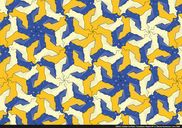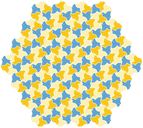|
Size: 7296
Comment:
|
Size: 7297
Comment:
|
| Deletions are marked like this. | Additions are marked like this. |
| Line 37: | Line 37: |
| * [[/2013/11] | * [[/2013/11]] |
Golden Ratio
Contents
1. Learning objectives
Your competency area 10 (D) Descriptive and Mathematical Modeling will make a quantum leap and you have an opportunity to create aesthetic qualities to be proud of.
2. Learning activities
Golden Ratio refers to the number 1.618033989... used by architects, painters and designers for centuries. It occurs frequently in what nature has designed for us. In an early version of our module we studied these phenomena, see for example the beautiful movie
http://govide.com/video/D4KSO648MADN/phi-the-nature-of-growth
At present we are ready to move much further than a simple ratio and explore relations between beauty and geometry, between aesthetics and mathematics. In this module we create patterns and symmetries, very much like Esher did. But we shall avail ourselves of powerful tools such as matrix algebra and Processing libraries for Turtle Graphics, Vectors and Mesh diagrams, next to the Speedy 300 laser cutter at HG 2.63. What we can achieve with such tools applied to colored plastic such as
and at the small exhibition at HG 3.42- HG 3.46.
But if you want, we could go further, perhaps explore fractals, cell structures, or connect to fashion, see for example
http://katinkata.blogspot.com/2010/06/womenswear-photoshoot.html
and
http://www.idemployee.id.tue.nl/l.m.g.feijs/voronoi.pdf
Professor Loe Feijs and Dr. Jun Hu will be your guide.
3. Schedule
4. List of available reference and background materials
Website: Official M.C.Escher website, http://www.mcescher.com/
Book: Heesch und Kienzle, Flachenschluss,Springer-Verlag, 1963, http://www.idemployee.id.tue.nl/l.m.g.feijs/flachenschluss.pdf
Book: Fejes Toth, Regular Figures, Pergamon Press 1964, http://www.idemployee.id.tue.nl/l.m.g.feijs/regular-figures.pdf
Software: Processing http://processing.org/
Tutorial: The golden ratio course, Bartneck and Feijs, TU/e 2008, http://www.bartneck.de/2008/05/21/the-golden-ratio-course/
Paper: Bartneck & Feijs, Teaching geometry to design students, http://www.digitalcultureandeducation.com/uncategorized/bartneck-2009-htm/
- Oogway library for turtle graphics
You can download a zip that includes everything: https://github.com/mrhujun/nl.tue.id.oogway/zipball/master. In this zip file there are two directories:
nl.tue.id.oogway: java code to build the oogway.jar for processing
nl.tue.id.tesselation.examples: using Oogway for tessellation, including TTTT, CGG, CCC. In this directory you can find the oogway.jar in "libraries". You can copy everything in the directory nl.tue.id.tesselation.examples to your processing sketchbook location.
The documentation is here: https://github.com/mrhujun/nl.tue.id.oogway/wiki/Oogway-Documentation
5. Information lecturers
Loe Feijs is professor Industrial Design of Embedded Systems. He studied electrical engineering and holds a Ph.D in computer science. He worked in telecommunication research (CSELT), telecommunication industry (PTI), in software research (Philips Nat Lab), in embedded systems (EESI), and in industrial design (TU/e). He was the director of the Eindhoven embedded systems institute. He has been vice-dean of ID from 2001 to 2006 with the responsibility of building-up ID research at TU/e. He (co-)authored several books on formal specifications and created mathematical theories of modular software design, such as lp calculus and relation partition algebra (RPA). Loe Feijs also likes hands-on work, witnessed by his 4D-sketching, Mondrian software and the assignment Timing Circuits.
Jun Hu has a PhD in Industrial Design and a Professional Doctorate in User-system Interaction, both from Eindhoven University of Technology (TU/e). He has also a B.Sc in Mathematics and a M.Eng in Computer Science. He is a System Analyst and a Senior Programmer, qualified in 1996 and 1994 respectively by the Ministry of Industry and Information Technology of China. He worked in signal processing as an software engineer at the Computational Center and Institute of Geophysics of Jiangsu Oil Exploration Co. (JEOCO) from 1990 to 1994, in management information systems and computer aided design at the Information Center of Shaanxi Construction Machinery Co. Ltd. (SCMC) from 1994 to 1996, in scientific data visualization at the department of computer science of Northwest University from 1996 to 1999. He was a research assistant at the Center of User-system Interaction of TU/e from 1999 to 2001. He was a researcher in the Media Interaction Group at Philips Research Eindhoven from 2000 to 2003. From 2006 to 2007 he served as the Secretary-General for The Association of Chinese Scholars and Engineers in the Netherlands (VCWI) and from 2008 to 2009 as the Chairman. He has been a board member of Center for Chinese Professionals in the Netherlands (CCPN) since 2009. He is now a tenured Assistant Professor at Department of Industrial Design, TU/e, a Guest Professor at School of Digital Media, Jiangnan University. He is an associated editor of the International Journal of Arts and Technology. He is an author of several open source and commercial software products. He has about 80 peer reviewed publications in conferences and journals in the field of HCI, industrial design, computer science and design education. His current research activities are directed towards Design Research on Social Computing
6. Something Interesting
The Golden Ratio Otherwise Known as Feng Shui by Mario van der Meulen, shared by Zhiyuan Zheng
7. Material suppliers
8. How to use this site
Interesting starting points:
RecentChanges: see where people are currently working
WikiSandBox: feel free to change this page and experiment with editing
FindPage: find some content, explore the wiki
HelpOnMoinWikiSyntax: quick access to wiki markup
A Wiki is a collaborative site, anyone can contribute and share:
Edit any page by pressing Edit at the top or the bottom of the page
Create a link to another page with joined capitalized words (like WikiSandBox) or with [[words in brackets]]
- Search for page titles or text within pages using the search box at the top of any page
See HelpForBeginners to get you going, HelpContents for all help pages.
To learn more about what a WikiWikiWeb is, read about MoinMoin:WhyWikiWorks and the MoinMoin:WikiNature.
This wiki is powered by MoinMoin.


